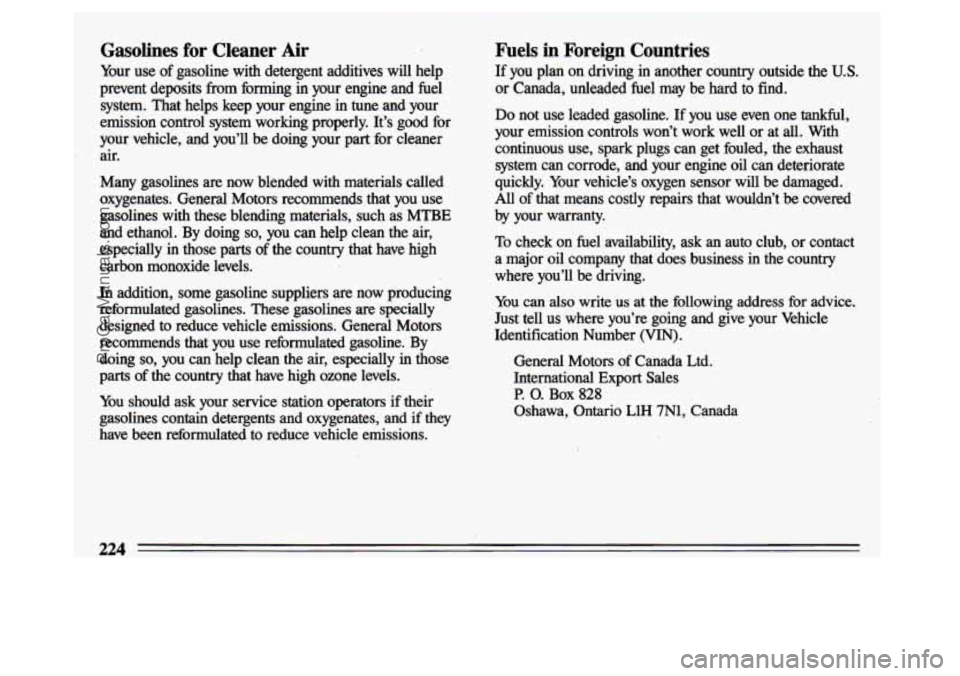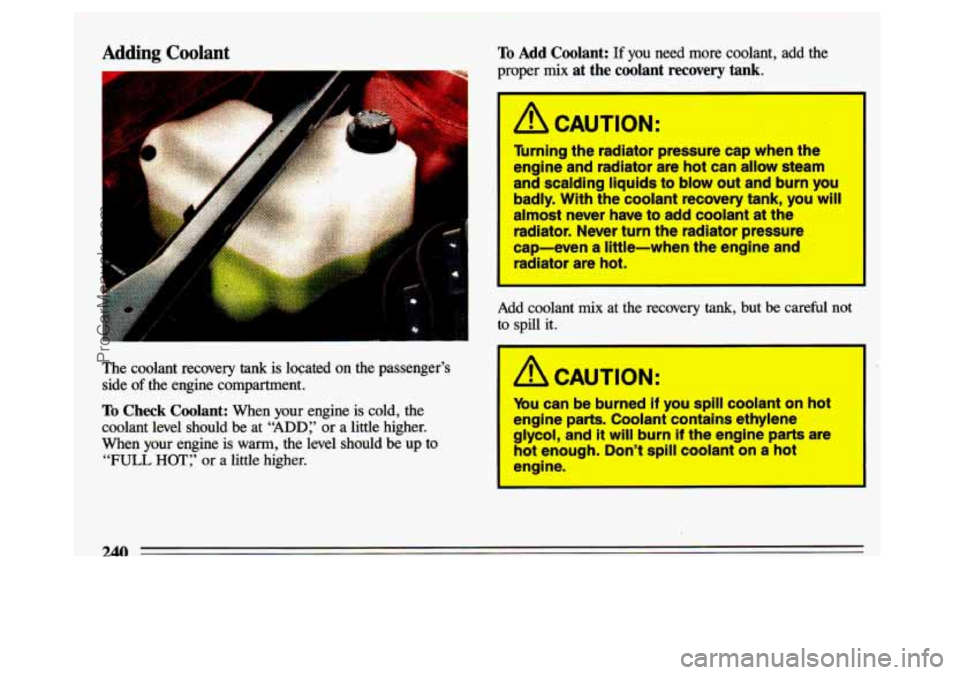Page 223 of 324

.
n
Part 6 Service and Appearance Care
. .
Here you will find information about the care of your Buick . This part begins with service and fuel information.
and then
it shows how to check important fluid and lubricant levels . There is also technical information about
your vehicle. and a section devoted to
its appearance care .
Part 6 includes:
Service ........................................................................\
..... 222
Fuel ........................................................................\
...... 223
HoodRelease ....................................................................... \
226
Engine Oil ........................................................................\
. 227
Aircleaner ........................................................................\
2.3
TransaxleFluid ..................................................................... 236
Enginecoolant ..................................................................... 239
Power Steering Fluid ................................................................. 241
Windshield Washer Fluid .............................................................. 242
Brakes ........................................................................\
.... 243
Battery ........................................................................\
.... 244
BulbReplacement ................................................................... 245
Tires ........................................................................\
...... 251
Loadingyourvehicle ................................................................. 249
Appearancecare .................................................................... 258
Vehicle Identification Number (VIN), Add-on Electrical Equipment ............................ 265
Capacities and Specifications .......................................................... -270
Fuses&CircuitBreakers .............................................................. 266
ReplacementBulbs .................................................................... 269
ProCarManuals.com
Page 226 of 324

Gasolines for Cleaner Air
Your use of gasoline with detergent additives will help
prevent deposits
from forming in your engine and fuel
system. That helps keep your engine in tune and your
emission control system working properly. It’s good for
your vehicle, and you’ll be doing your part for cleaner
air.
Many gasolines
are now blended with materials called
oxygenates. General Motors recommends that you use gasolines
with these blending materials, such as MTBE
and ethanol.
By doing so, you can help clean the air,
especially
in those parts of the country that have high
carbon monoxide levels.
In addition, some gasoline suppliers are now producing
reformulated gasolines. These gasolines are specially
designed to reduce vehicle emissions. General Motors recommends that you use reformulated gasoline. By
doing
so, you can help clean the air, especially in those
parts of the country that have high ozone levels.
You should ask your service station operators if their
gasolines contain detergents and oxygenates, and if they
have been reformulated to reduce vehicle emissions.
F’uels in Foreign Countries
If you plan on driving in another country outside the U.S.
or Canada, unleaded fuel may be hard to find.
Do not use leaded gasoline. If you use even one tankful,
your emission controls won’t work well or at
all. With
continuous use, spark plugs can get fouled, the exhaust
system can corrode, and your engine oil can deteriorate
quickly. Your vehicle’s oxygen sensor will be damaged.
All of that
means costly repairs that wouldn’t be covered
by your warranty.
To check on fuel availability, ask an auto club, or contact
a major oil company that does business in the country
where
you’ll be driving.
You
can also write us at the following address for advice.
Just tell us where you’re going and give your Vehicle Identification Number
(VIN) .
General Motors of Canada Ltd.
International Export Sales
P. 0. Box 828
Oshawa, Ontario L1H 7N1, Canada
I
224
ProCarManuals.com
Page 229 of 324
/i CAUTION:
Things that burn can get on hot engine parts
and start
a fire. These include liquids like
gasoline, oil, coolant, brake fluid, windshield
washer and other fluids, and plastic or rubber.
You or others could be burned. Be careful not
to drop
or spill things that will burn onto a hot
engine.
Before closing the hood, be sure all the filler caps are on
properly. Then just pull the hood down and close it
firmly.
Engine Oil
I‘
I
It’s a good idea to check your engine oil every time you
get fuel. In order to get an accurate reading, the oil must
be warm and the vehicle must be on level ground. The
3300 V6 engine oil dipstick is located near the front and
center
of the engine compartment.
ProCarManuals.com
Page 230 of 324
The 2.2L LA engine oil dipstick is located in the fill cap
near the front and center of the engine compartment.
Turn off the engine and give the oil a few minutes to
drain back into the oil pan.
If you don’t, the oil dipstick
might not show the actual level.
To Check Engine Oil: Pull out the dipstick and dean it
with a paper towel or cloth, then push it back in
all the
way. Remove it again, keeping the tip lower.
When to Add Oil: If the oil is at or below the “ADD”
line, then you’ll need to add some oil. But you must use
the right kind. This section explains what kind of
oil to
use. For crankcase capacity, see “Capacities and Specifications”
in the Index.
228 i
ProCarManuals.com
Page 235 of 324
Air Cleaner
.-
If you have the 3300 V6 engine, your air cleaner is on the
driver’s side
of the engine compartment. To check or
replace the filter, release the latches and pull the air
cleaner open. Refer
to the Maintenance Schedule to
determine when to replace the air filter. See “Scheduled
Maintenance Services” in the Index.
I
Remove and replace the filter, then close the cover and
latches.
ProCarManuals.com
Page 236 of 324
If you have the 2.2L L4 engine, your air cleaner is on the
driver's side
of the engine compartment. To check or
replace the filter, use a screwdriver to loosen the hose
clamp, then lift the rubber duct. Refer to the Maintenance Schedule to determine when to replace the air filter. Remove the wing nut and pull
off the cover.
234
ProCarManuals.com
Page 238 of 324

Automatic ‘mansaxle Fluid
When to Check and Change:
A good time to check your automatic transaxle fluid level
is when the engine oil is changed. Refer to the
Maintenance Schedule to determine when to change your
fluid. See “Scheduled Maintenance Services” in the
Index.
How to Check:
Because this operation can be a little difficult, you may
choose to have
this done at a Buick dealership Service
Department.
If you do it yourself, be sure to follow all the instructions
here, or you could get a false reading on the dipstick. Wait at least
30 minutes before checking the transaxle
fluid level
if you have been driving:
When outside temperatures are above 90°F (32°C).
At high speed for quite a while.
In heavy traffic-especially in hot weather.
While pulling a trailer.
To get the right reading, the fluid should be at normal
operating temperature, which is
180°F to 200” F (82” C to
93°C).
Get the vehicle warmed up by driving about 15 miles
(24 km) when outside temperatures are above 50°F
(10°C). If it’s colder than 50” F (lO°C), you may have to
drive longer.
To check the fluid level:
Park your vehicle on a level place.
0 Place the shift lever in “P” (Park) with the parking
brake applied.
With your foot on the brake pedal, move the. shift lever
through each gear range, pausing for about three
seconds in each range. Then, position the shift lever in
“P” (Park).
Let the engine run at idle for three to five minutes.
236
ProCarManuals.com
Page 242 of 324

Adding Coolant
..
The coolant recovery tank is located on the passenger’s
side
of the engine compartment.
To Check Coolant: When your engine is cold, the
coolant level should be at “ADD:’
or a little higher.
When your engine
is warm, the level should be up to
“FULL HOT:’ or a little higher.
To Add Coolant: If you need more coolant, add the
proper
mix at the coolant recovery tank.
/i CAUTION:
Turning the radiator pressure cap when the
engine and radiator are hot can allow steam
and scalding liquids to blow out and burn you
badly.
With the coolant recovery tank, you will
almost never have
to add coolant at the
radiator. Never turn the radiator pressure
cap-even
a little-when the engine and
radiator are hot.
Add coolant mix at the recovery tank, but be careful not
to spill it.
A CAUTION:
You can be burned if you spill coolant on hot
engine parts. Coolant contains ethylene
glycol, and
it will burn if the engine parts are
hot enough. Don’t spill coolant on
a hot
engine.
240
ProCarManuals.com